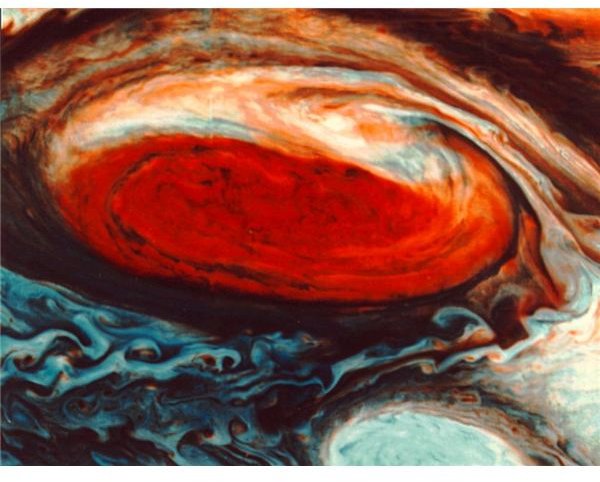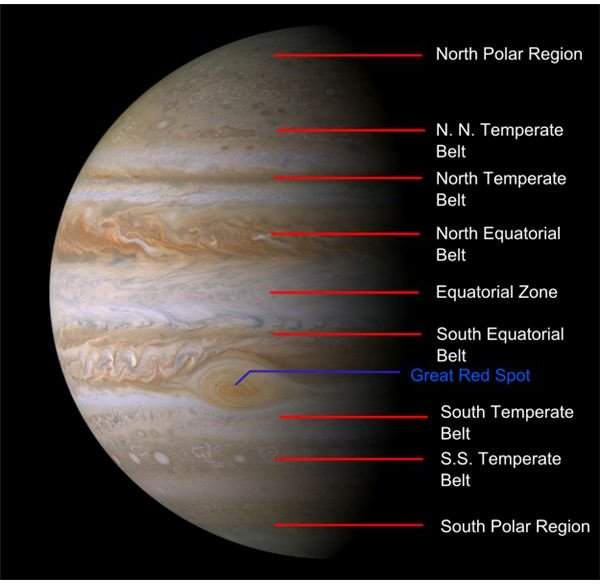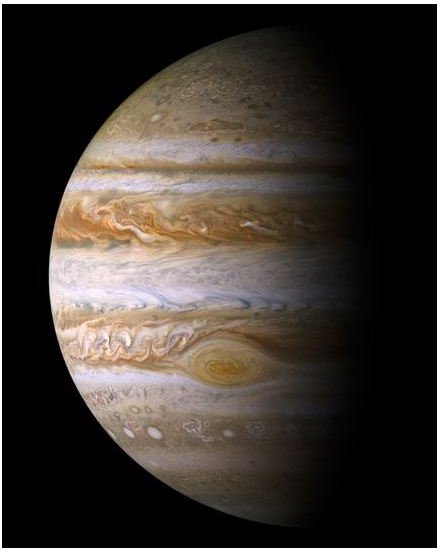Information About the Great Red Spot of Jupiter
What is the Great Red Spot of Jupiter
The Giant or Great Red Spot of Jupiter is an anticyclonic storm. A cyclone is a rapid circulation of air in an inward direction with a low pressure center. It circles counterclockwise in the northern hemisphere and clockwise in the southern hemisphere. The direction of rotation is reversed for high pressure systems, i.e. the Red Spot comes out of the center of a high pressure storm system. The Red Spot is located in the southern hemisphere of the planet.
To understand how the Red Spot got there, you have to understand something about the Jupiter atmosphere. There are four layers to the atmosphere, the troposphere, as you go higher in altitude it becomes the stratosphere, then the thermosphere, and finally the exosphere, which is the highest level. Unlike the Earth, Jupiter does not have a solid surface, which means that the lowest atmospheric layer, i.e. the troposphere, turns into the planet’s fluid interior. The Red Spot is an atmospheric system that is more than 300 years old. There are storm-like features associated with winds can be seen to the left and above the Red Spot. The direction of the atmospheric flow is from east to west.
The atmosphere is mostly made of hydrogen and helium and it contains the same proportion of gas as the Sun, which is about 75% hydrogen and 24% helium. The remaining chemicals appear only in small amounts and include methane, ammonia, hydrogen sulfide and water.

Other information about Jupiter’s weather can be read here: Let’s Find Out: What is the Weather Like on Jupiter
Temperature Variation of the Jupiter Atmosphere and the Red Spot
Besides the chemical variation, and the different atmospheric bands, there is also temperature variation. The atmosphere goes from near absolute zero at the highest atmospheric levels to almost 10000 degrees F.near the core.

The interior of the Red Spot goes from a -250 degrees F. to -256 degrees F. This makes the Red Spot “warm” compared to its surroundings. One effect is that this causes hurricane-like storms in the atmosphere, and since the hurricanes on Jupiter don’t go over land, they tend to last for decades or centuries because there is nothing to stop them or interfere with their speed. The atmosphere has a wide range of active elements, including vortices, which have cyclones and anticyclones, storms and lightning. The vortices are large red, white or brown spots shaped like ovals. The largest two vortices are the Great Red Spot and Oval BA, which is also red. These two and most of the other large spots are anticyclonic.
The Red Spot has a wavy cloud pattern because to the left of the Red Spot there is a region of complex wave motion. The rotation of the spot is counter-clockwise. And finally, at this time, even though much is known about the Great Red Spot, the one thing that astronomers do not know is how it got its color, and why it stays that way.
The Dimensions of the Great Red Spot
The size of the Great Red Spot is enormous. Up to three Earths could fit within its boundaries, and it has persisted for at least the last 400 years that astronomers have observed it through telescopes. The Great Red Spot rotates counterclockwise, it rotates in period of about six Earth days or about 14 Jovian days. Its physical dimensions are between 24,000 and 40,000 kilometers west–to–east (about 15,000 to 25000 miles) and 12–14,000 km (7500 to 15500 miles ) south–to–north.

Another interesting point about the Red Spot is that it is getting smaller. Around 2004, observations noticed that the Great Red Spot was about half in longitudinal length that it had been a 100 years ago; then it was 40,000 km in diameter. This means that it could eventually have a circular appearance by 2040. This condition, however, probably won’t last long ever if it does occur because of the distortion effect of the neighboring jet streams in the atmosphere.
For other information about Jupiter read Interesting Facts About the Planet Jupiter
Historical Facts and Observations
Two astronomers were responsible for discovering and describing the Great Red Spot. The first sighting goes to Robert Hooke in May 1664, who described a spot on the planet. The second astronomer is Giovanni Cassini who described a “permanent spot” in the 1665. Cassini’s spot was observed from 1665 to 1713. Robert Hook’s spot is controversial, because it is placed the spot in the wrong belt altogether, that is the North Equatorial Belt, instead of the current location which is in the South Equatorial Belt.
During a fly-by in 1974, Pioneer 11 took pictures of Jupiter and the Great Red Spot. Later, other important pictures were taken of the Red Spot when on February 25, 1979 Voyager 1 was 9.2 million km (5.7 million mi) from Jupiter.
In 1989, NASA sent the Galileo space craft to Jupiter. Its mission was to study Jupiter and its moons in more detail than any previous spacecraft. It arrived in 1995 and made discoveries of water beneath the surface in several moons. NASA destroyed it in 2003, to protect one of its discoveries, a possible ocean under the crust of the moon Europa.
See Nothing but the Facts about Giovanni Cassini
You can also read about What We Know About Jupiter and What We Can Learn from the JUNO Mission
Sources
https://zebu.uoregon.edu/ph121/l15.html
https://abyss.uoregon.edu/~js/ast121/lectures/lec19.html
https://nineplanets.org/jupiter.html
https://burro.astr.cwru.edu/stu/advanced/jupiter.html
What is the Great Red Spot of Jupiter?
Image, Courtesy of Nasa/JPL, licensed in the public domain, https://en.wikipedia.org/wiki/File:PIA04866_modest.jpg
Red Spot Image, Published by Nasa and the Jet Propulsion Laboratory, https://nssdc.gsfc.nasa.gov/photo_gallery/photogallery-jupiter.html, Image is in the public domain.
Temperature Variation of the Jupiter Atmosphere and the Red Spot
Jupiter Belt System, Image, Published under the Wikmedia Commons License, https://en.wikipedia.org/wiki/File:Jupiter_Belt_System.svg
The Dimensions of the Great Red Spot
Jupiter cloud Bands, Image, Published under the Wikemedia Commons License, https://en.wikipedia.org/wiki/File:Jupiter_cloud_bands.svg
About its shrinking size see: https://www.space.com/6386-jupiter-great-red-spot-shrinking.html
You can view the timeline for The Great Red Spot
